It’s review season again! Theros Beyond Death offers us some new toys for cube owners and I’m excited to get into it with you.
First, Sagas are in fact back. Sagas play out well and their countdown mini-games excellent for limited. There are certainly a few new ones in Theros Beyond Death that have exceeded my expectations after some testing.
In addition we have a fistful of new enchantment gods, remixed from their original incarnations. And perhaps the most important of all is Escape, which has proved itself to be far above even my highest expectations. As it turns out, spells you can cast over and over again—even with some restrictions—can feel broken.
Then there’s constellation, or enchantments-matter. This is the (relatively) parasitic mechanic of the set. Most of these cards won’t make it into our cubes without serious commitments to supporting the archetype. As such, I’ll only be touching on cards which hold an inherent power level and don’t rely on too much on synergy. However, it’s possible that Theros Beyond Death has opened up the possibility of an enchantments-matter archetype in rarity restricted cubes.
I will not be giving out letter grades, but I’ll rate my top cards at the end of the article. We’ll be going in WUBRG color order, then Multicolor and Colorless.
Don’t miss my reviews of Blue and Black.
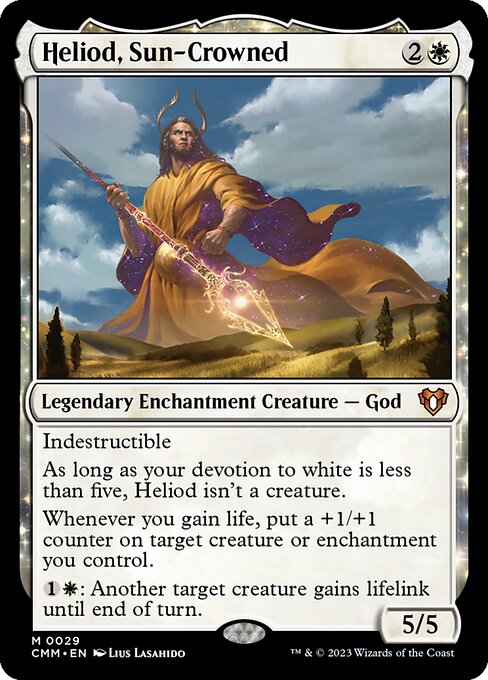
Heliod, Sun-Crowned
A word on the Gods: Don’t consider these threats as creatures but indestructible enchantments. Getting to enough devotion to “wake up” the Gods is never a guarantee and in most games has been difficult—and not without the possibility of being punished for trying. Evaluating them should begin and end with the power of their static and activated abilities.
With Heliod, Sun-Crowned, of course, we do get an infinite combo kill with Walking Ballista. This is strong but inconsistent in a singleton format like Cube, so I wasn’t convinced going in that Heliod was worth the slot based on this “Splinter Twin” win condition. So far, I don’t find either of his abilities to be very relevant. Gaining life is fine against, say, Mono-Red specifically, but even then I’d rather have a body on the battlefield for my mana investment. Paying three mana in cube should have a bit more impact than what Heliod offers.
In fact, when Heliod does wakes up, you’re attacking with a 5/5…which is good but not amazing. Odds are if you’re attacking with Heliod you’re probably winning the game already, so who cares about another 5/5? Cube just isn’t really about the Heliod life and do we even need to make Walking Ballista better than it already is? I’m passing on him, and I think you should too.
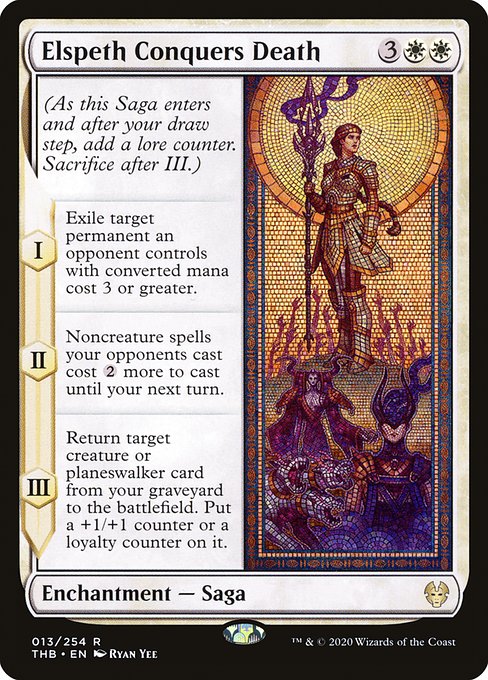
Elspeth Conquers Death
After getting beaten by this card enough times in Theros Beyond Death draft I decided to test Elspeth Conquers Death in my cube and I was not disappointed. In fact, the more I play with and against it the more I’m convinced this Saga is well worth its inclusion in White.
Chapter I slots well into almost any White deck. Exiling something with converted mana cost of three or greater means you’re usually interacting with something you care about, be it an opposing Planeswalker, a pesky sword, or hard to kill threats like The Scarab God or Hazoret the Fervent. As a curve topper it helps your aggressive deck stay ahead. For a control deck it’s a clunky, but serviceable removal spell.
The second ability isn’t great for limited, but in Cube it’s had some moments of relevance. It strains the opponents ability to interact for a turn, and if you’re pressing an advantage, especially against a control deck, it can approximate a Time Walk. That being said, there’s often too much that has to go right for the average second chapter to feel like you gotten any value. So don’t expect too much from this uptick.
The third chapter is essentially Miraculous Recovery but with some additional non-flavor text: being able to target any of your Planeswalkers in the graveyard. Beyond the obvious value of reanimating your best threat, I’ve had the pleasure of firing off Gideon, Ally of Zendikar‘s emblem multiple times. Having access to such a unique reanimate effect makes me want to try and recur the Saga if at all possible. Eternal Witness and Cavalier of Dawn are excellent targets for Chapter III, and don’t forget you can also use the effects on Flickerwisp or Venser, Shaper Savant to get repeated use of out Elspeth Conquers Death!
Yes, it’s admittedly a bit slow, but never feels like a dead draw. I think you’re get enough value out of this card that you’ll be happy to include it in any environment that will allow it.
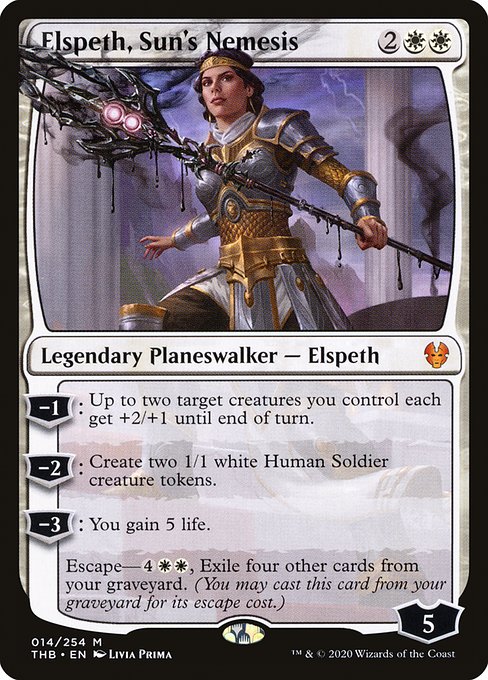
Elspeth, Sun’s Nemesis
There’s been so much written and said about Elspeth, Sun’s Nemesis already that i’m not sure what else I can contribute to the conversation. Having played with it, and read about countless others experiences with the card, I’m almost convinced this is one of the best White Planeswalkers ever printed.
Many of the arguments over whether Elspeth should be in our cubes comes down to “is this better than that?” comparisons involving our other two proven four-drop Planeswalkers: Gideon, Ally of Zendikar and Elspeth, Knight-Errant. And while I don’t think there’s a hard conclusion on this —and there shouldn’t be—I do think that we have enough Planeswalkers in White that we can now be a bit more selective. So, how do we know when we want Elspeth, Sun’s Nemesis in our cube?
That Elspeth makes Humans is no small thing. I support a small Human sub-theme in White and have always wanted a Planeswalker that generated Humans instead of Solider or Knight tokens. Elspeth also makes two creatures, which is, of course, always great when beating down but also gives you more of a board presence when playing from behind. This, combined with her ability to gain life, makes Sun’s Nemesis an excellent choice for your control decks. Unlike Gideon or Knight-Errant, this Elspeth is not only playable, but good in basically any White deck.
We’ve already seen how big an impact the Escape mechanic has had on our cubes. On balance, using Escape to recur our threats has proven easier than imagined. That this mechanic is on a Planeswalker has me convinced we’ll be casting a lot of Elspeth, Sun’s Nemesis going forward. If this card is part of the push to make White stronger, i’m on board.
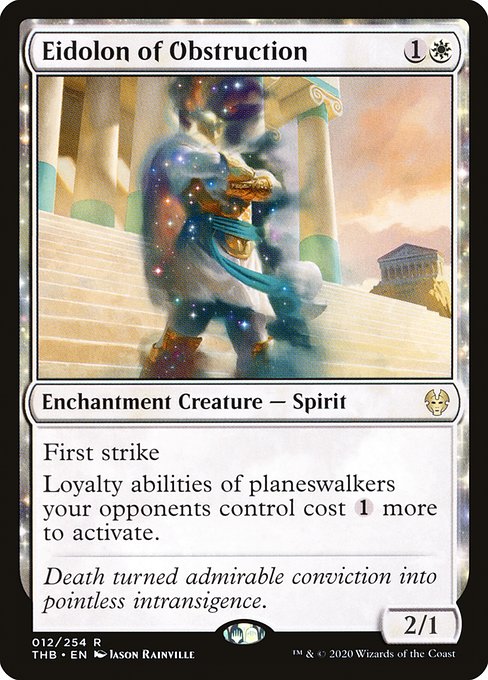
Eidolon of Obstruction
I’m always in the market for another good hatebear. Eidolon of Obstruction, while good in theory, doesn’t exactly get there in practice. I’m hesitant to see this static effect be effective outside of a Planeswalker-heavy environment that supports a very aggressive White aggro shell alongside Mana Tithe, Wasteland, and Strip Mine. Because, really, aren’t those the best aggressive White cards?
On curve this is fine, but nothing special, and rarely has the taxing impact you want it to have. As a late game topdeck Eidolon is abysmal unless you follow it up with something ridiculously powerful like Armageddon.
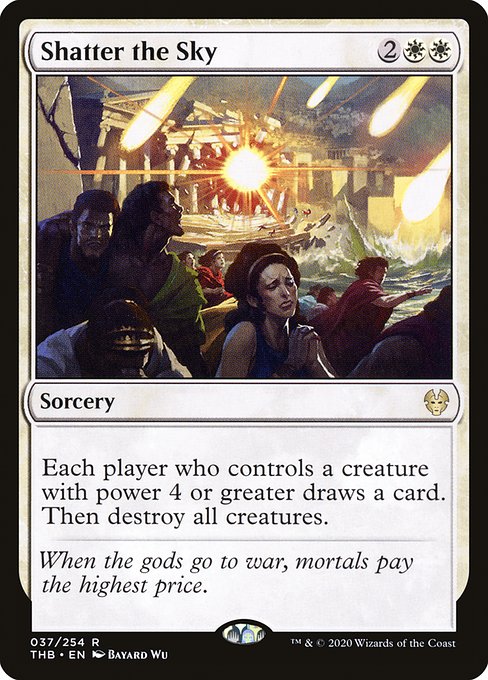
Shatter the Sky
A Wrath of God variant with a drawback as serious as this isn’t necessary until your cube is at 720 or higher and you crave redundancy. And no, turning this drawback into “replacing itself” by sweeping your own massive creature isn’t a solution. I would caution anyone looking to play this, even with a very good reason, by simply replacing it with another sweeper.
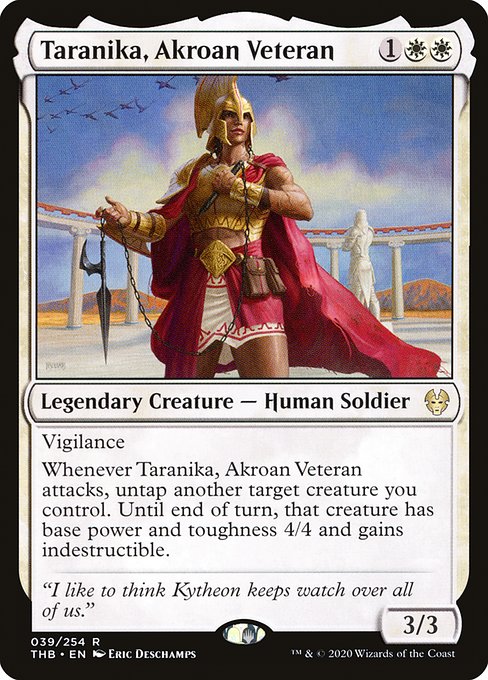
Taranika, Akroan Veteran
Taranika plays like a fixed Geist of Saint Traft. And by that I mean: she’s much easier to kill and requires an actual board presence to get full value.
Testing with Taranika has been fairly predictable. When she’s played on turn three and is unopposed she’s a favorite to run away with the game, but around turn five or six the board is usually too clogged up for her to matter. I really like this card, and it might be that I’m trying to make fetch happen, but Taranika represents another strong design move for White that i’m going to support.
As I stated in my first takes article, protect her and she’ll close the game fast. The strongest sequence I’ve seen so far is curving her into Elspeth, Knight Errant, which is just a massive amount of pressure. I’ve also seen her off the top of the deck and act like a Nessian Courser. So the variance is there, which, if you’re into that kinda thing like I am, then make room for Taranika.
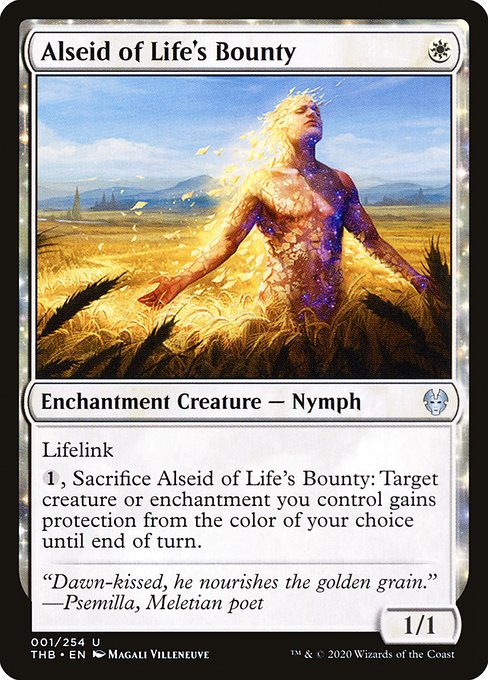
Alseid of Life’s Bounty
Protecting the Queen is an excellent way to win a game of Magic, and Alseid of Life’s Bounty is our new protection spell. Except it’s closer to a one-shot Mother of Runes activation than God’s Willing. The effect is on the board, can get into combat, and even gain us some life. I’m a huge fan of the Alseid in Theros Beyond Death limited and it should slot perfectly into our Peasant cubes.
Alseid of Life’s Bounty is a good beginning to an enchantments-matter sub-theme, too. Once we can effectively recur this creature after protecting our key threat, we’ve really got a stew going. And that’s not even necessary to validate this card’s power level. If you’ve ever lost to Mother of Runes—and I know you have—you can respect how powerful even one activation can be during the course of a game.
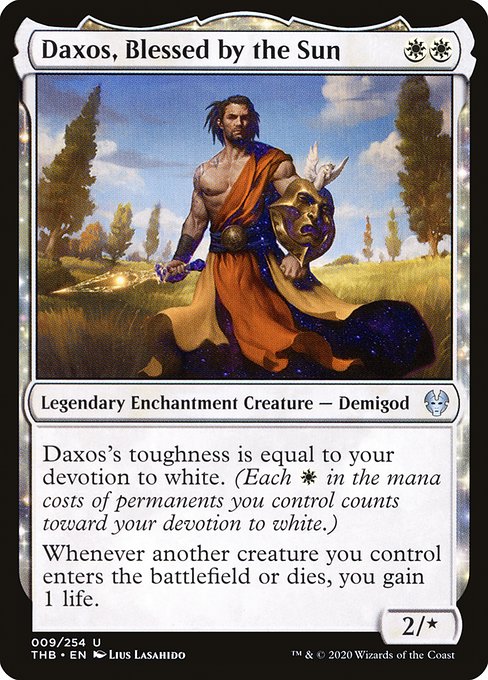
Daxos, Blessed by the Sun
This card seems tailor made for Peasant cubes alongside Soul Warden and Ajani’s Pridemate. As we’ve seen in limited, Daxos can get real thicc, making him an excellent defensive body on the ground while you close the game with fliers. Taking advantage of Daxos’s lifegain static is best with tokens or alongside the extort mechanic.
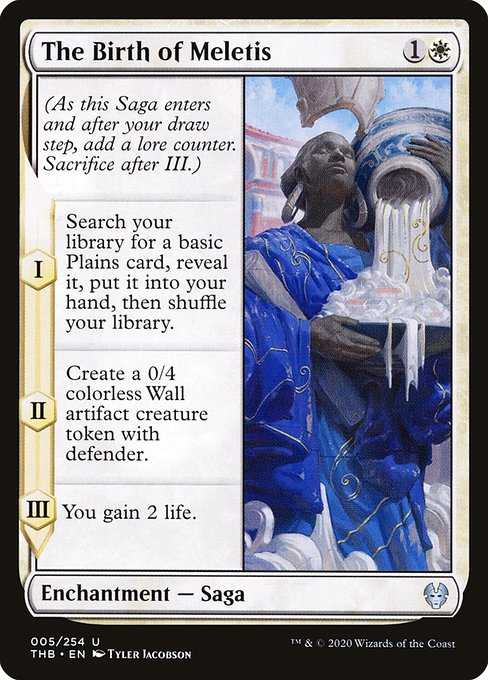
The Birth of Meletis
I’m excited to try The Birth of Meletis in Peasant cube as a second Wall of Omens. Generally speaking, White doesn’t get a lot of access to good cheap defensive plays like this. It’s slow, and not a great topdeck, but play this early and you’re getting much more than two mana for your investment. I would want to support this Saga as well as Dominaria’s Triumph of Gerrard with some recursive elements like Lotus-Eye Mystics. With the printing of Theros Beyond Death it’s possible that an enchantments-matter sub-theme in White and Green happens, and I think Birth of Meletis will be a part of the equation.
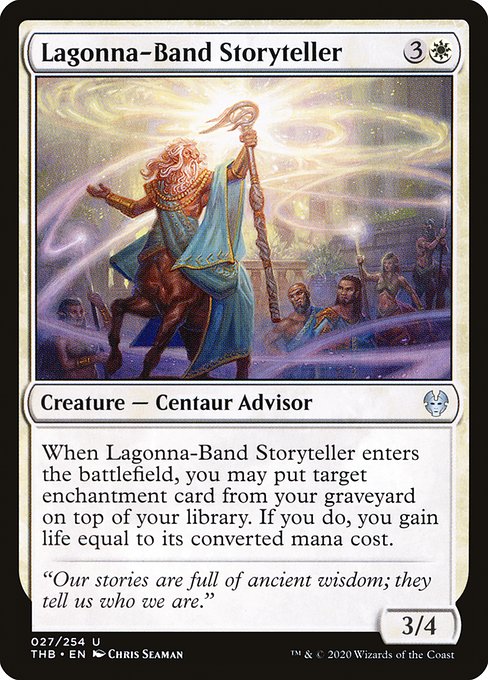
Lagona-Band Storyteller
Speaking of enchantments-matter sub-themes! Similar to the aforementioned Lotus-Eye Mystics, Lagona-Band Storyteller can rebuy your concluded Sagas or a Faith Unbroken that fell off your creature. A four mana 3/4 is a decent defensive body and the small bit of lifegain makes up for the enchantment not returning to your hand. This is a fine card, if a bit slow, and if you’re looking for a more controlling White deck at the Peasant level this could definitely be a solid value play. I’d look to support this alongside Green or Black.
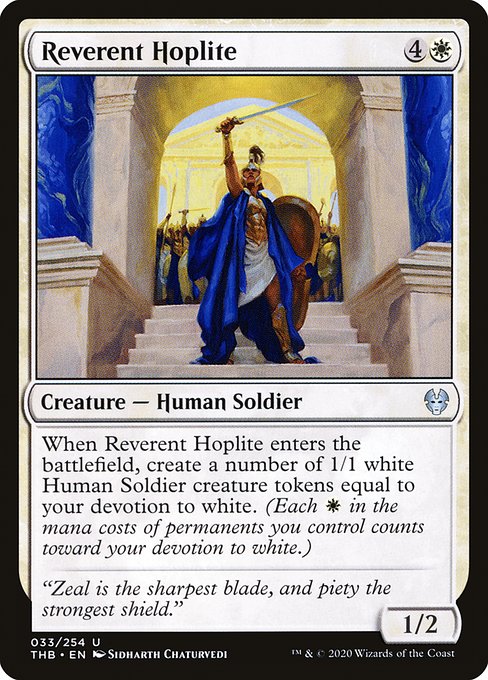
Reverent Hoplite
Holy Devotion! Reverent Hoplite has a very high ceiling for a token deck in Peasant environments. White aggressive decks want to swarm the board and get game-ending value off Intangible Virtue or Rally the Peasants, and this card bolsters the top end of the tokens archetype. Like most linear strategies, the failstate on Reverent Hoplite isn’t great, but we’re not putting cards like these in our cubes without being able to effectively build around it.
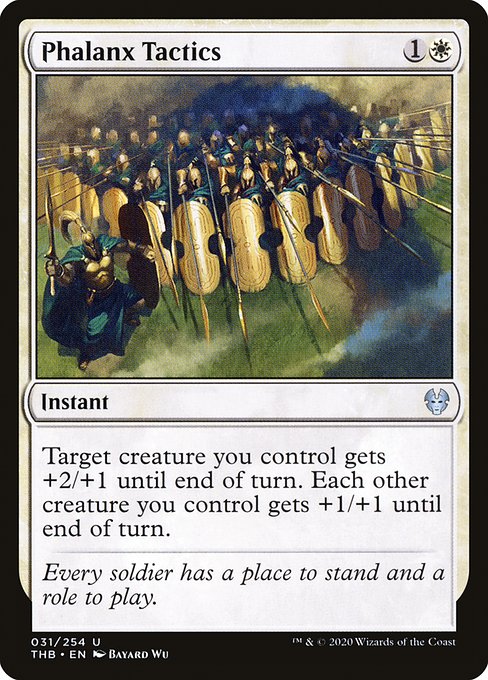
Phalanx Tactics
So once we have our Reverent Hoplite and a bunch of tokens, we get to win with Phalanx Tactics! This is a much needed spell for White token decks in Peasant cubes. Similar to Tenacity or Pride of the Conquerers, this is an excellent bit of redundancy for your go-wide decks.
Power Rankings—White
Powered/Legacy
Peasant/Pauper
- Reverent Hoplite
- Alseid of Life’s Bounty
- Daxos, Blessed by the Sun
- Phalanx Tactics
- The Birth of Meletis
White gets a couple of uniquely powerful cards at Rare/Mythic, and a bevy of excellent cards for Peasant cubes. I’m looking forward to seeing if i’m right about the enchantments-matter sub-theme that’s more available to us now, and will be reporting back with results.
Tune in next week when we go over Blue! Thanks for reading.

